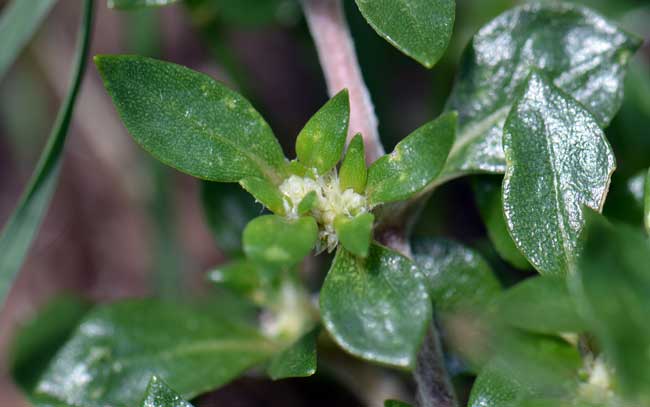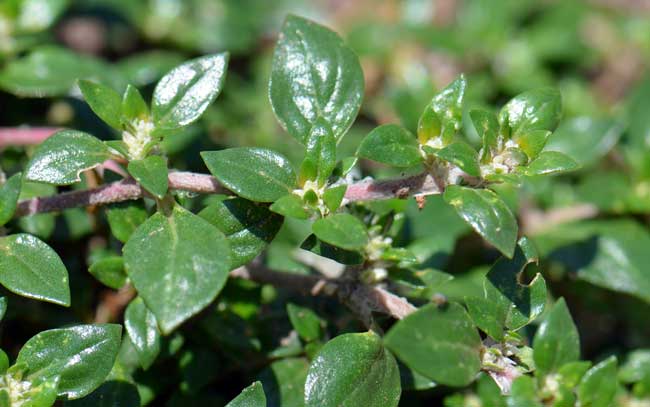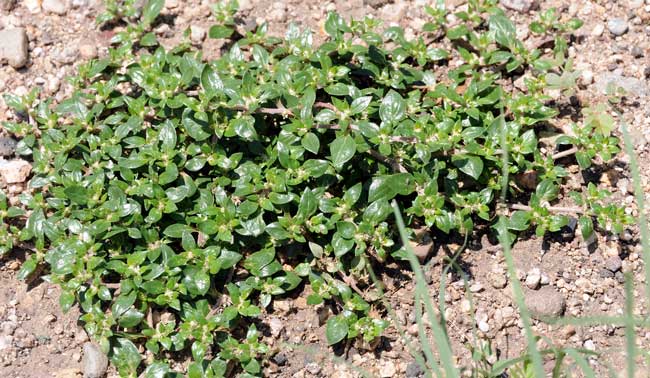Alternanthera caracasana, Khaki Weed



Scientific Name: Alternanthera caracasana
Common Name: Khaki Weed
Also Called: Mat Chaff-flower, Washerwoman
Family: Amaranthaceae, Pigweed Family
Synonyms: (Achyranthes peploides, Achyranthes repens, Alternanthera peploides, Alternanthera pungens, Alternanthera repens)
Status: Introduced: Native to Central and South America.
Duration: Perennial
Size: Up to 3 feet.
Growth Form: Forb/herb; heavily stemmed, woody root, spreading along the ground (procumbent), forming mats.
Leaves: Bright green; opposite, glabrous, leaves variable, oval or obovate with short sharp flexible point, paired leaves of unequal size throughout, petioles, clasping.
Flower Color: Whitish, yellowish or straw colored, mostly inconspicuous; sepals only, lanceolate, sharp pointed, sessile in axillary spikes, flowers surrounded by conspicuous white bracts; fruit is a one seeded utricle.
Flowering Season: August to October.
Elevation: sea level to 6,000 feet.
Habitat Preferences: Gravel, sand bars, sidewalks; 0-2000 m; Generally waste places.
Recorded Range: Khaki Weed is an introduced species found in the southern part of the United States in; AL, AR, AZ, CA, FL, GA, HI, LA, MD, MO, MS, NC, NM, OK, SC and TX. It is also introduced in Baja California and northern and central Mexico and Hawaii. It is native to Puerto Rico, the Virgin Islands and Central and South America.
North America & US County Distribution Map for Alternanthera caracasana.
U.S. Weed Information: No data available.
Invasive/Noxious Weed Information: In North America, the genus Alternanthera is listed as a Noxious Weed by the state of Arkansas. Plants included here are invasive or noxious.
Wetland Indicator: No data available.
Threatened/Endangered Information: No data available.
In the Southwestern United States, Arizona has 3 species of Alternanthera, California has 1 species, Nevada has 0 species, New Mexico has 1 species, Texas has 7 species and Utah has 0 species. All data is approximate and subject to taxonomic changes.
Comments: Khaki Weed is low growing, mat forming resilient species with whitish flowers and conspicuous white bracts tightly tucked in among leaf axil. It is distinctive and conspicuous, almost striking with its bright green leaves of varying shape and size. It is generally listed as a weed, a noxious weed in Arkansas, often found growing in disturbed areas and a variety of habitats.
In Southwest Desert Flora also see a closely related species also called "Khakiweed", Alternathera pungens with which is it often confused.
Khaki Weed is similar is appearance and habitat to another member of the Amaranth family, Small Matweed, Guilleminea densa, also an Amaranth found in Arizona.
Additionally, parts supposedly have been used by the people of Chinchero, Peru as a tea during childbirth.

